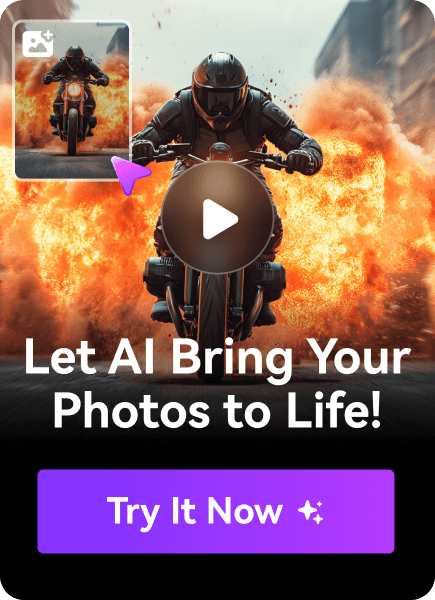
They say nothing beats in-person employee training. However, what if you have remote workers? Online training videos for employees may be your only option.
The best part? They can be more engaging than regular training. On-demand videos can also benefit on-site employees, giving them 24/7 access to crucial information about company policies and processes.
Are you ready to make a compelling employee training video? Before diving into the steps, let’s see what that video may entail and how it can benefit your business.
In this article
What Is an Employee Training Video?

An employee training video is a visual medium for sharing knowledge and teaching various skills. They can include images, infographics, charts, and other materials to help viewers understand company products and procedures. They can also feature a trainer explaining topics and delivering critical information like the company’s mission, vision, and policies.
The best employee training videos include interactive elements like quizzes and game-like simulations. They help acquire knowledge faster and retain information longer, which brings us to the benefits of making staff training videos.
The Importance of Staff Training Videos

Training your employees is crucial for your organization’s long-term growth. Here are the most notable benefits of doing it through videos:
- Higher engagement – Videos can capture viewers’ attention through interactive elements and compelling storytelling, boosting the learning motivation and making it fun.
- Better knowledge retention – People are visual and auditory learners. That makes videos superior to text-based materials, making the content more memorable and empowering employees to apply what they’ve learned in day-to-day operations seamlessly.
- Higher productivity – Unlike in-person training, videos don’t take precious time away from daily tasks. For instance, you don’t need to schedule a meeting for every new policy or procedure update. You can create a video for employees to watch at a more convenient time, making them more productive at work.
- Accessibility – On-demand videos available 24/7 enable employees to gain new skills anytime and anywhere, providing the flexibility of self-paced learning.
- Time and cost savings – Video-based employee training is less time-consuming and more cost-efficient than its in-person counterpart. That especially rings true when you have multiple business locations.
- Training consistency – Whether sharing new employee training videos or empowering existing workers, you can ensure everyone receives the same information, eliminating problems or mistakes. You can deliver consistent, standardized messages, which may not be true when having multiple trainers.
- Measurable outcomes – Many digital tools like LMSs (Learning Management Systems) can help you track and analyze employee training videos to measure effectiveness. Besides gaining insight into your trainees’ strengths and weaknesses, you can check your videos’ performance through completion rates (e.g., quizzes and challenges), viewing time, and other metrics.
Now that you know why you should make employee training videos, it’s time to learn how.
How to Make an Employee Training Video
Employee training videos require thorough preparation. Let us walk you through the essential steps.
Define the Goal of Your Video

What do you want to accomplish with your training video? Do you wish to teach your employees new skills? Do you want to introduce your company and onboard new hires? Is workplace safety or diversity your primary focus?
Once you determine your goal, write down all the objectives because they’ll help you create relevant training content.
Let’s say you want to make customer service training videos for employees. One objective for achieving excellence in that department could be reducing response time to one minute.
Choose a Suitable Training Video Type
Your training videos can feature tutorials, explainer videos, product demos, and show-and-tell footage of on-site experiences. They can feature long-form content (e.g., a PowerPoint presentation) or bite-sized chunks for microlearning. Whatever you choose, here are the best video types to consider.
Presenter-Style Video

Presenter-style or talking-head videos feature an instructor or trainer explaining a topic, concept, procedure, policy, or anything else. The presenter is typically in a classroom-like setting and often showcases relevant visuals like graphs.
Some examples perfect for this type are new hire orientation videos, learning and development, and hearing conservation training videos for employees.
Webcam Recording

This training video type is the fastest and most straightforward to create. You only need a high-quality webcam and microphone. It’s ideal for a company orientation video for welcoming new hires and introducing the vision, mission, core values, policies, and job expectations.
It can also be an excellent introduction to onboarding training videos, informing new employees about what to expect in the following training stage.
Screen Recording

Screen recordings can help employees master the necessary tools for daily operations. They can include step-by-step instructions for using particular software, responding to customer support tickets, creating invoices, etc.
You can also capture your screen and webcam to create a new employee orientation video, sharing a glimpse of what to expect on the job.
Video Presentation

Video presentations are excellent for explaining various concepts in a slideshow. PowerPoint presentations can be information-heavy, so converting them into videos with voiceover narration can boost engagement and eliminate misunderstandings.
A presentation format is also suitable for an induction video for new employees, helping them understand their responsibilities and specific positions’ roles.
Interactive Video

Interactive videos can have quizzes, role-playing simulations, branching scenarios, and other clickable elements trainees can interact with to better understand concepts, improve problem-solving skills, and retain knowledge. They work perfectly as compliance videos for employees.
You can also use this type for HR training videos for employees. Various real-life simulations and branching scenarios can help you mold HR experts.
These examples are only the tip of the iceberg. All employee development videos can be interactive because that dramatically boosts learning engagement, motivation, and knowledge retention.
Animated Video

Animated videos are excellent for simplifying complex concepts, showcasing various techniques (e.g., sales or marketing), and outlining behavioral expectations. Animations are ideal for workplace diversity training videos because they can compare inappropriate and respectful behavior without making anyone uncomfortable (as opposed to live-action footage).
You can also animate onboarding training videos and department-related training clips. They can explain standard and emergency procedures for handling customer complaints, maintaining workplace safety, meeting quality control standards, etc.
Whiteboard Video

Whiteboard videos fall into the animation category but can be more engaging than traditional animations. They’re typically fast-paced, featuring a hand drawing pictures on a whiteboard to explain complex procedures or abstract concepts (e.g., customer satisfaction). They can captivate viewers with compelling storytelling.
You can use them for almost anything, including HR, customer service, and respectful workplace training videos.
Create a Storyboard for Your Employee Training Video

A storyboard isn’t necessary for all employee training videos. For instance, outlining your talking points on paper is enough for a presenter-style video, webcam recording, or screencast. However, other video types require a visual representation for thorough planning and production. That’s vital when creating a video in a team because everyone will stay on the same page.
Many tools provide storyboard templates for online employee training videos. However, you can make hand-drawn sketches of every shot and add notes to explain them, highlighting the crucial actions and elements.
Write a Script for Your Training Video
Your training video’s success is directly proportional to its script. A well-thought-out script provides structure and streamlines video creation, helping you determine the video’s length.
It’s beneficial even for screen and webcam recordings because it makes them more professional. It guides the information flow, helping you stay on track and eliminating the risk of missing crucial information.
However, writing a script can be the most challenging part of making an employee training video. After all, you want to grab and hold your trainees’ attention while helping them learn new skills or understand tools and concepts.
The good news is you can leverage AI to save time and effort while getting a well-crafted script. The Wondershare Virbo is an excellent choice. It can quickly generate AI scripts and make free training videos for employees.
Virbo uses a GPT-4 language model and is perfect for product demos. It can hook you up with 20 scripts for free. The premium version (starting at $19.99/month) removes that limit and unlocks many other AI features.
Here’s how to generate an AI script using Wondershare Virbo on Android or iOS:
Step 1: Download and install Wondershare Virbo on your smartphone by scanning the QR code below.


Step 2: Launch the app and register or log into your account.

Step 3: Choose the AI script feature.

Step 4: Specify the language, type your product name, and pick a text style. Then, provide all the relevant keywords and selling points and tap Generate Script. The more information you give, the more accurately Virbo will meet your expectations.
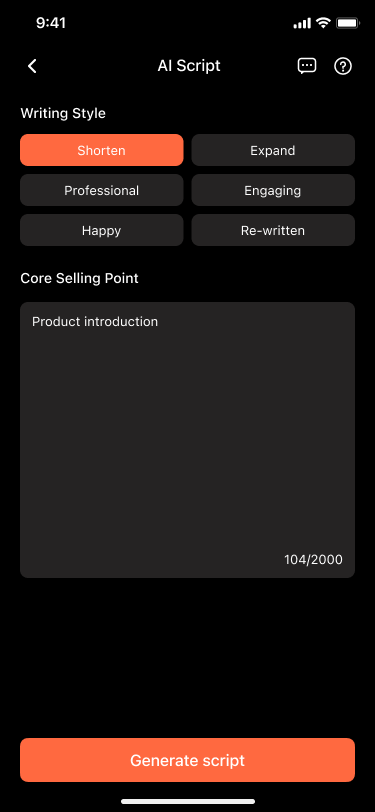
Step 5: Once Virbo works its AI magic, copy the script to the clipboard and save it on your device. Alternatively, edit it in Virbo and tap Create Video to make a script-based training video using AI.

Step 6: Choose an AI avatar, record a voiceover, and fine-tune the video further. You can change the background and template and add music, text, stickers, and subtitles. Adding more scenes is also an option, but the free version limits your video to one minute. Once you finish editing, tap Export to save the video to your device.

Create an Employee Training Video Using AI
Wondershare Virbo for mobile is excellent for creating AI avatar videos, generating AI scripts, and turning text into lifelike speech using 300+ voices.
However, you only get product-related AI scripts and vertical videos for mobile devices. Still, they can help train your social media marketing team besides providing you with promotional videos. Of course, you can import your script and make any employee training video.
Do you prefer making videos on a computer but don’t want to download anything? Try Wondershare Virbo Online, which shares features with its mobile counterpart and supports landscape and portrait modes.
However, only Wondershare Virbo for Windows lets you import an employee training PPT presentation and convert it into a video. Here’s how:
Step 1: Download and install Wondershare Virbo for Windows.
Step 2: Launch the software and log into your account (or create a new one).

Step 3: Click Create Video and select a layout. Then, click Import PTT and upload your PowerPoint presentation.
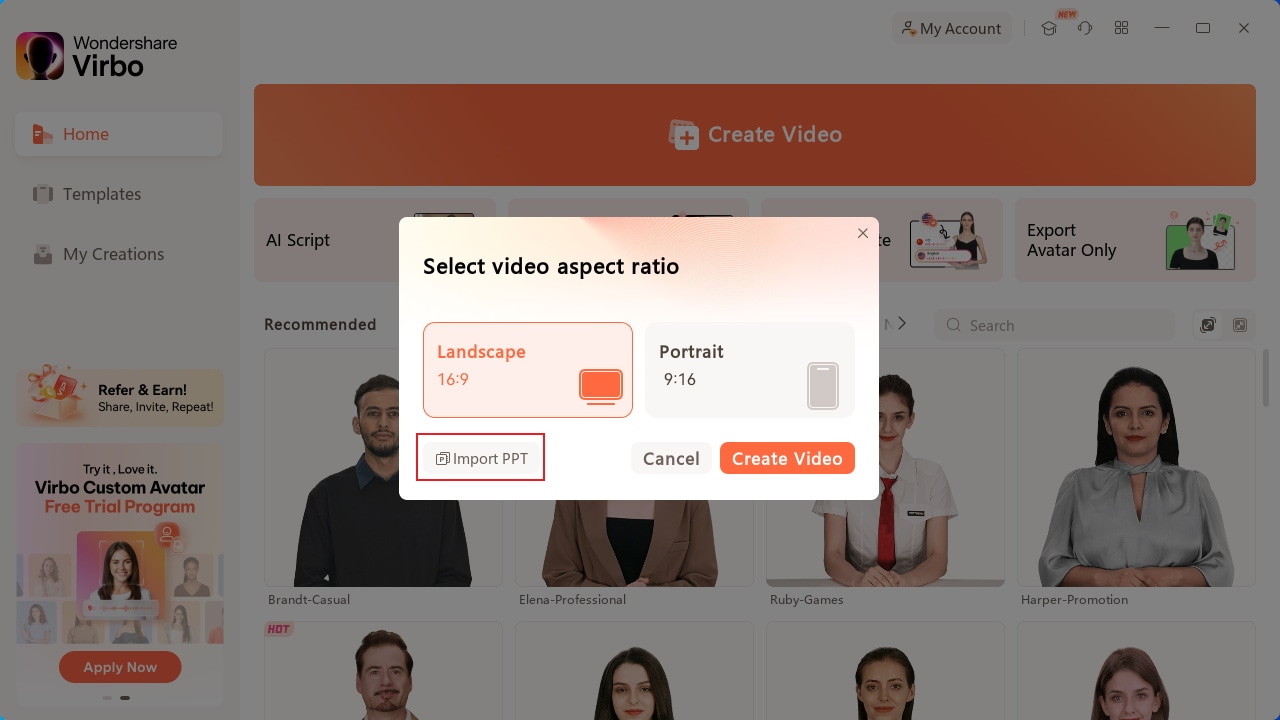
Step 4: Choose whether to extract the script and click Create Video.
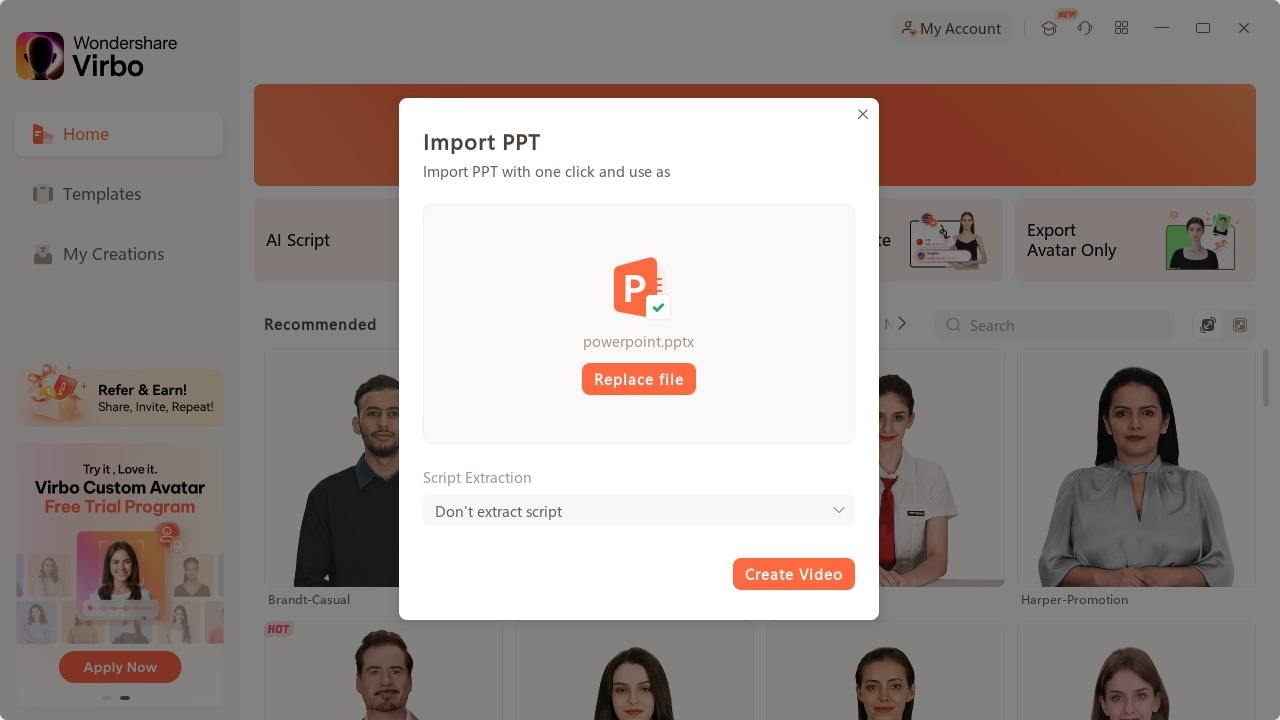
Step 5: Click the Avatar icon in the toolbar and choose from 300+ characters, many ideal for diversity training videos for employees.
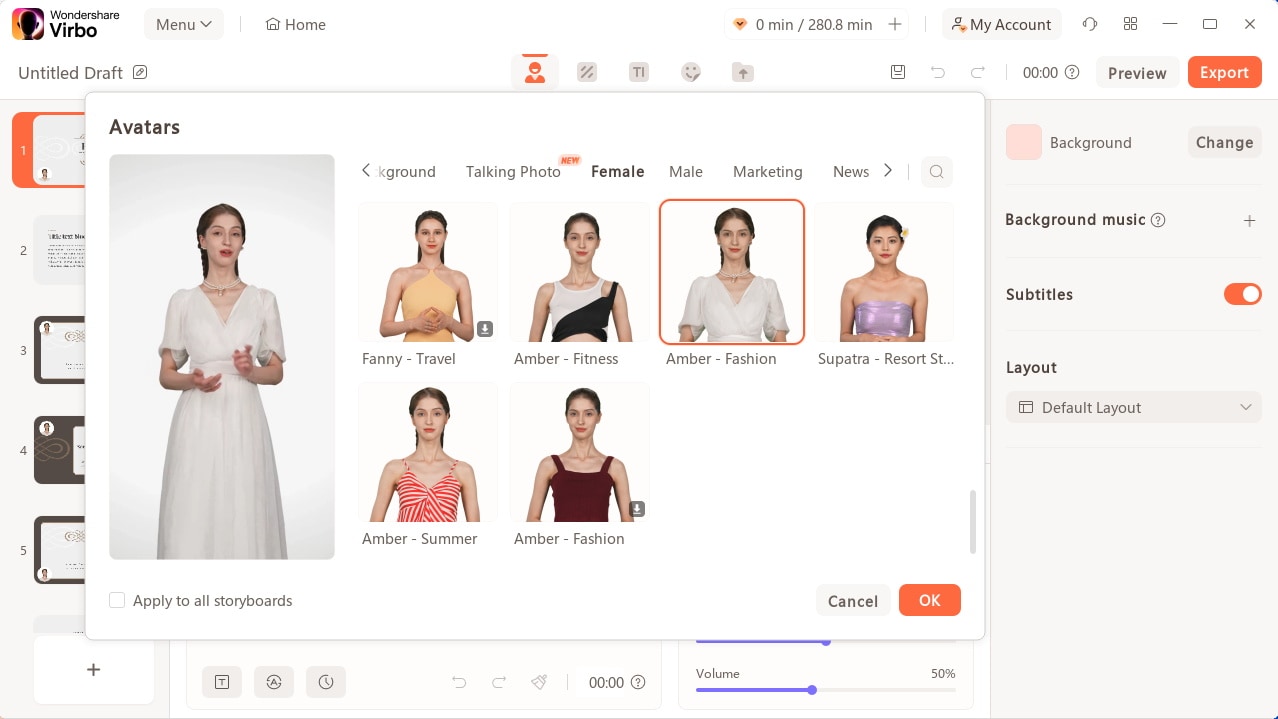
Step 6: Click Text Script or Audio Upload to add a voiceover and adjust the speed, pitch, and volume.
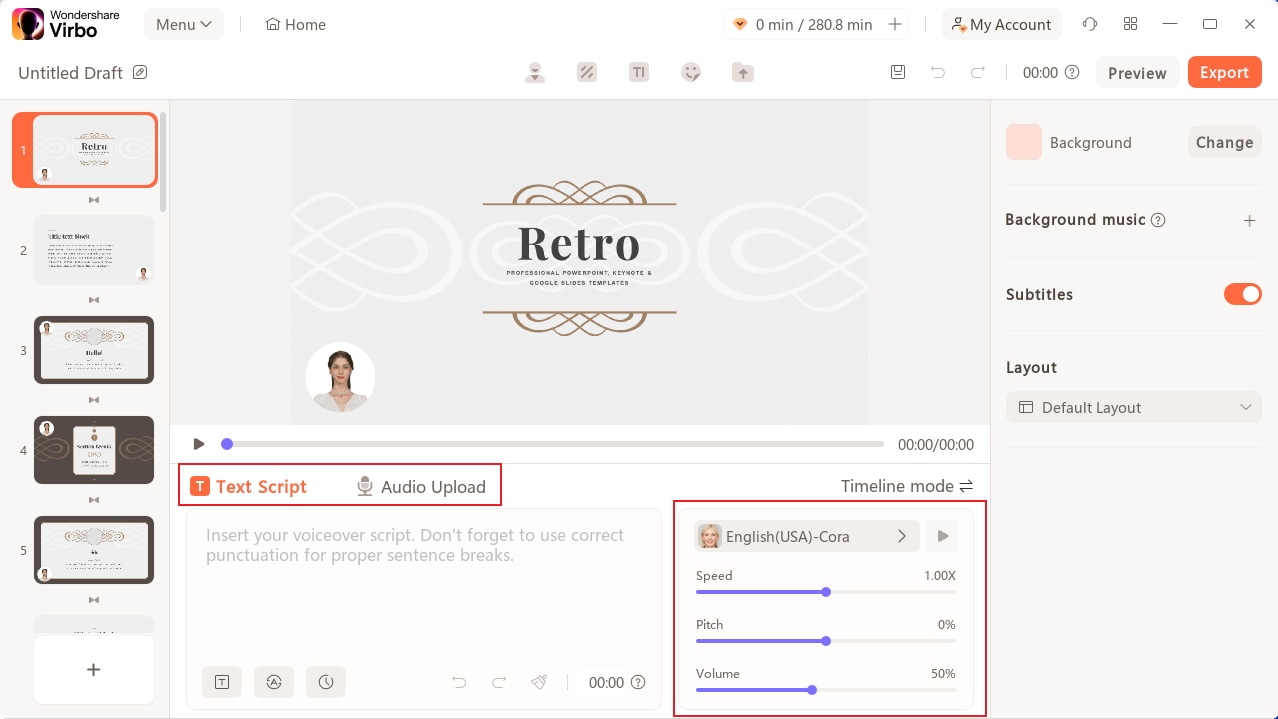
Step 7: Change the background and add music, text, subtitles, and stickers.
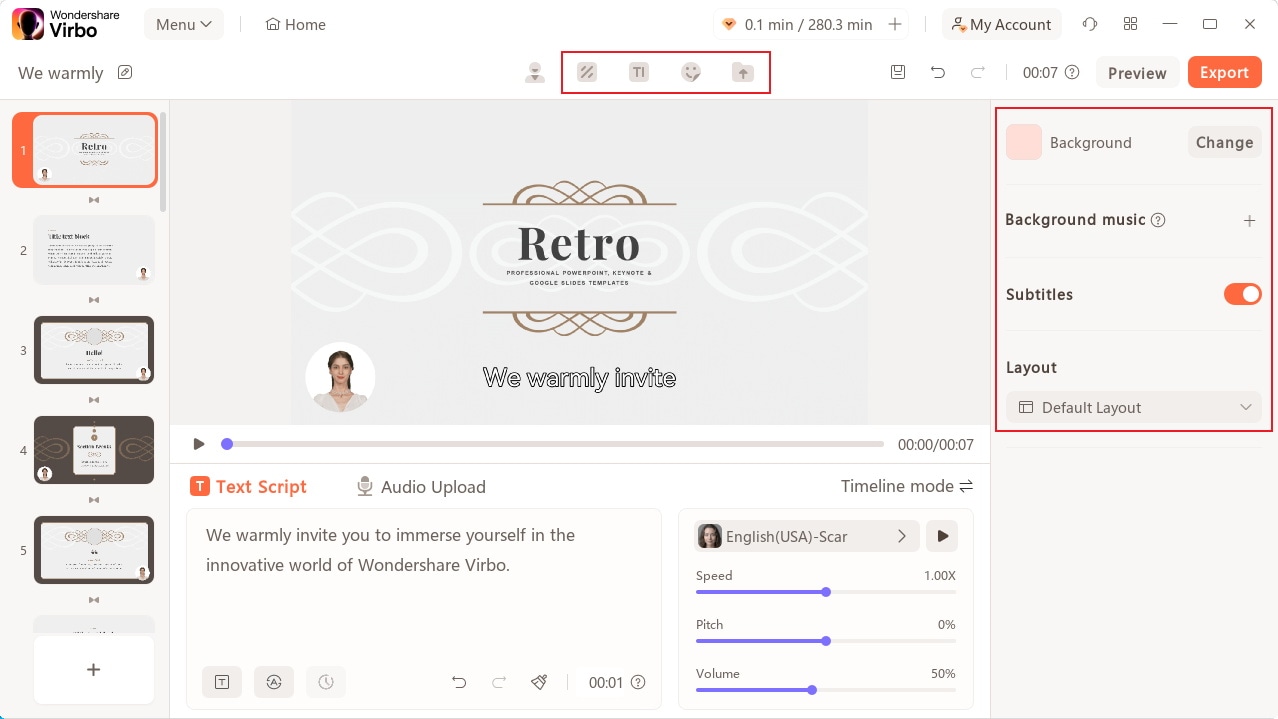
Step 8: Click Preview to watch your training video and Export to save it to your device.
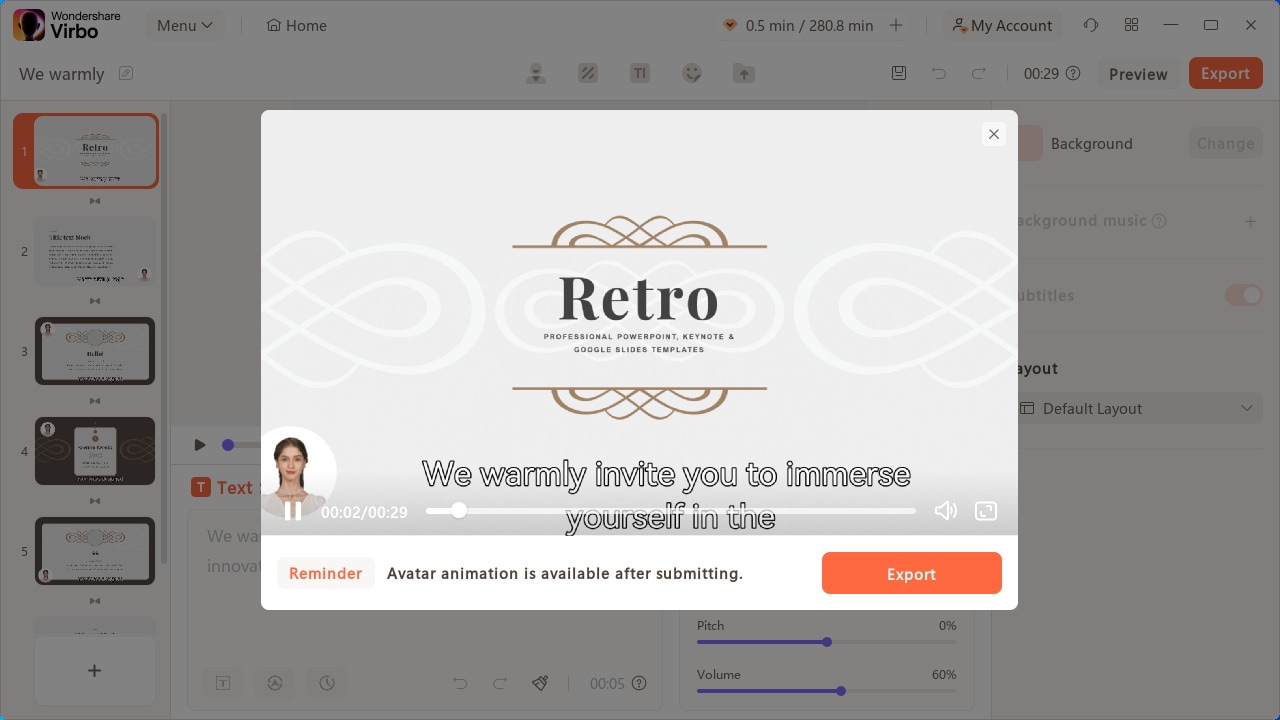
Conclusion
Making an employee training video doesn’t need to be complex and time-consuming or burn a hole in your wallet. With user-friendly tools like Wondershare Virbo, you can quickly make free employee training videos using cutting-edge AI.
You only need to define your goals and objectives, choose a suitable training video type, and create a storyboard to guide you. Wondershare Virbo can handle the rest.


